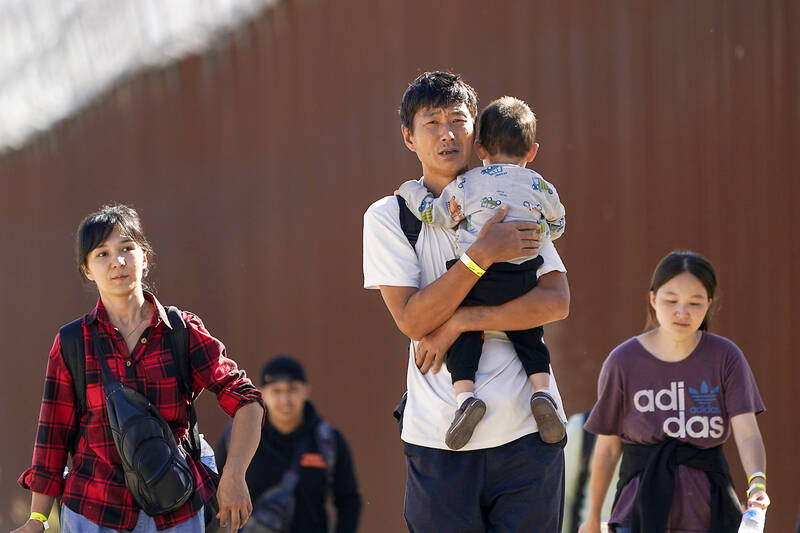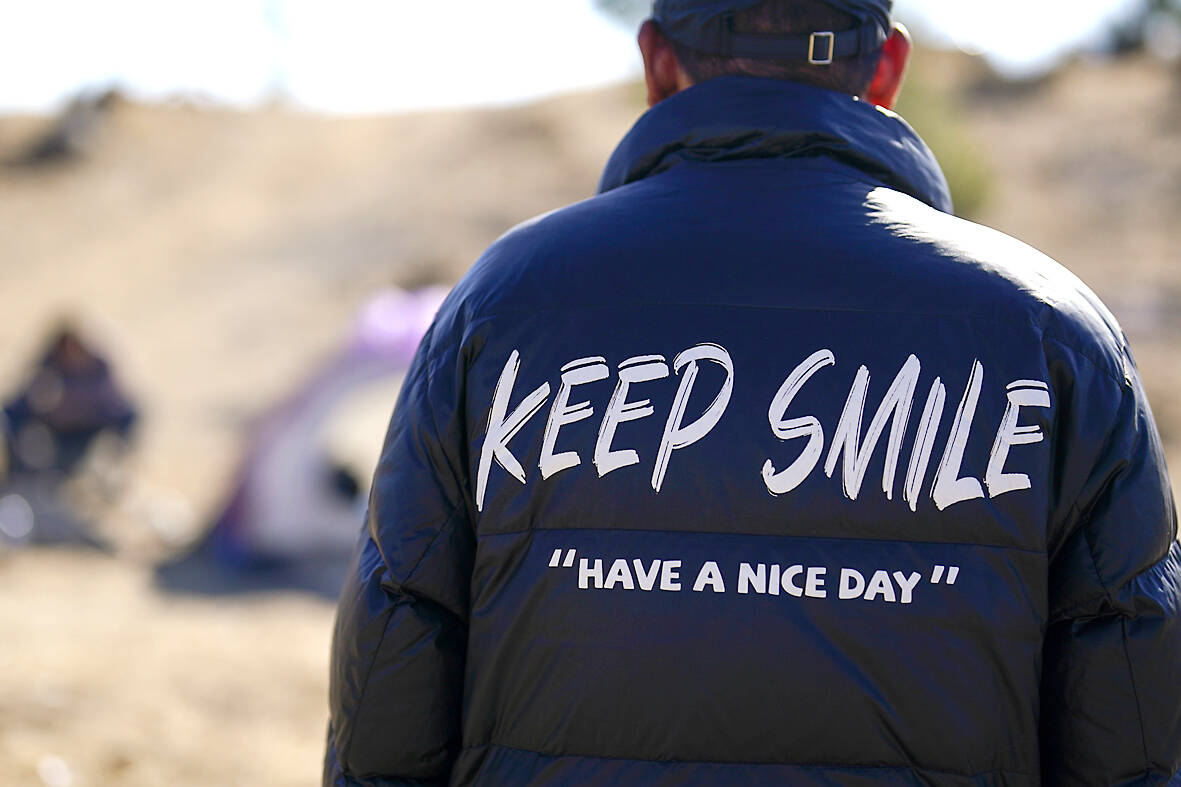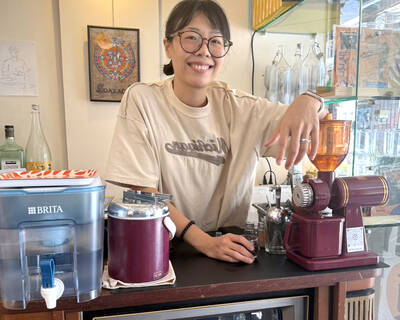The young Chinese man looked lost and exhausted when Border Patrol agents left him at a transit station. Deng Guangsen, 28, had spent the last two months traveling to San Diego from the southern Chinese province of Guangdong, through seven countries on plane, bus and foot, including traversing Panama’s dangerous Darien Gap jungle.
“I feel nothing,” Deng said in the San Diego parking lot, insisting on using the broken English he learned from Harry Potter movies. “I have no brother, no sister. I have nobody.”
Deng is part of a major influx of Chinese migration to the US on a relatively new and perilous route that has become increasingly popular with the help of social media. Chinese people were the fourth-highest nationality, after Venezuelans, Ecuadorians and Haitians, crossing the Darien Gap during the first nine months of this year, according to Panamanian immigration authorities.

Photo: AP
Chinese asylum-seekers, as well as observers, say they are seeking to escape an increasingly repressive political climate and bleak economic prospects.
They also reflect a broader presence of migrants at the US-Mexico border — Asians, South Americans and Africans — who made September the second-highest month of illegal crossings and the US government’s 2023 budget year the second-highest on record.
The pandemic and China’s COVID-19 policies, which included tight border controls, temporarily stemmed the exodus that rose dramatically in 2018 when President Xi Jinping (習近平) amended the constitution to scrap the presidential term limit. Now emigration has resumed, with China’s economy struggling to rebound and youth unemployment high. The UN has projected China will lose 310,000 people through emigration this year, compared with 120,000 in 2012.

Photo: AP
RUNNING AWAY
It has become known as runxue (潤學), or the study of running away. The term started as a way to get around censorship, using a Chinese character whose pronunciation spells like the English word “run” but means “moistening.” Now it’s an Internet meme.
“This wave of emigration reflects despair toward China,” Cai Xia, editor-in-chief of the online commentary site of Yibao and a former professor at the Central Party School of the Chinese Communist Party in Beijing.

Photo: AP
“They’ve lost hope for the future of the country,” said Cai, who now lives in the US. “You see among them the educated and the uneducated, white-collar workers, as well as small business owners, and those from well-off families.”
Those who can’t get a visa are finding other ways to flee the world’s most populous nation. Many are showing up at the US-Mexico border to seek asylum. The Border Patrol made 22,187 arrests of Chinese for crossing the border illegally from Mexico from January through September, nearly 13 times the same period last year.
Arrests of Chinese people peaked at 4,010 in September, up 70 percent from August to become the ninth-highest nationality at the US border and the highest outside of Mexico, Central and South America. The vast majority were single adults.
The popular route to the US is through Ecuador, which has no visa requirements for Chinese nationals. Migrants from China join Latin Americans there to trek north through the once-impenetrable Darien and across several Central American countries before reaching the US border. The journey is well-known enough it has its own name in Chinese: walk the line, or zouxian (走線).
The monthly number of Chinese migrants crossing the Darien has been rising gradually, from 913 in January to 2,588 in September. For the first nine months of this year, Panamanian immigration authorities registered 15,567 Chinese citizens crossing the Darien. By comparison, 2,005 Chinese people trekked through the rainforest last year, and just 376 in total from 2010 to 2021.
GUIDES
Short video platforms and messaging apps provide not only on-the-ground video clips but also step-by-step guides from China to the US, including tips on what to pack, where to find guides, how to survive the jungle, which hotels to stay at, how much to bribe police in different countries and what to do when encountering US immigration officers.
Translation apps allow migrants to navigate through Central America on their own, even if they don’t speak Spanish or English. The journey can cost thousands to tens of thousands of dollars, paid for with family savings or even online loans.
It’s markedly different from the days when Chinese nationals paid smugglers, known as snakeheads, and traveled in groups.
With more financial resources, Xi Yan, 46, and her daughter Song Siming, 24, didn’t trek the Ecuador-Mexico route, but instead flew into Mexico via Europe. With help from a local guide, the two women crossed the border at Mexicali into the US in April.
“The unemployment rate is very high. People cannot find work,” said Xi Yan, a Chinese writer. “For small business owners, they cannot sustain their businesses.”
Xi Yan said she decided to leave China in March, when she traveled to the southern city of Foshan to see her mother but had to leave the next day when state security agents and police officers harassed her brother and told him that his sister was not allowed in the city. She realized she was still on the state blacklist, six years after being detained for gathering at a seaside spot to remember Liu Xiaobo (劉曉波), a Nobel peace laureate who died in a Chinese prison. In 2015, she was locked up for 25 days over an online post remembering the victims of the 1989 Tiananmen Massacre.
Her daughter, Song, agreed to leave with her. A college graduate, the daughter struggled to find work in China and became depressed, the mother said.
Despite the challenges to survive in the US, Xi Yan said it was worth it.
“We have freedom,” she said. “I used to get nervous whenever there was a police car. Now, I don’t have to worry about it anymore.”

Cheng Ching-hsiang (鄭青祥) turned a small triangle of concrete jammed between two old shops into a cool little bar called 9dimension. In front of the shop, a steampunk-like structure was welded by himself to serve as a booth where he prepares cocktails. “Yancheng used to be just old people,” he says, “but now young people are coming and creating the New Yancheng.” Around the corner, Yu Hsiu-jao (饒毓琇), opened Tiny Cafe. True to its name, it is the size of a cupboard and serves cold-brewed coffee. “Small shops are so special and have personality,” she says, “people come to Yancheng to find such treasures.” She

Late last month Philippines Foreign Affairs Secretary Theresa Lazaro told the Philippine Senate that the nation has sufficient funds to evacuate the nearly 170,000 Filipino residents in Taiwan, 84 percent of whom are migrant workers, in the event of war. Agencies have been exploring evacuation scenarios since early this year, she said. She also observed that since the Philippines has only limited ships, the government is consulting security agencies for alternatives. Filipinos are a distant third in overall migrant worker population. Indonesia has over 248,000 workers, followed by roughly 240,000 Vietnamese. It should be noted that there are another 170,000

Hannah Liao (廖宸萱) recalls the harassment she experienced on dating apps, an experience that left her frightened and disgusted. “I’ve tried some voice-based dating apps,” the 30-year-old says. “Right away, some guys would say things like, ‘Wanna talk dirty?’ or ‘Wanna suck my d**k?’” she says. Liao’s story is not unique. Ministry of Health and Welfare statistics show a more than 50 percent rise in sexual assault cases related to online encounters over the past five years. In 2023 alone, women comprised 7,698 of the 9,413 reported victims. Faced with a dating landscape that can feel more predatory than promising, many in

“This is one of those rare bits of TikTok fitness advice with a lot of truth behind it,” says Bethan Crouse, performance nutritionist at Loughborough University. “Sometimes it’s taken a bit too literally, though! You see people chugging protein drinks as they’re scanning out of their gym.” Crouse recommends the athletes she works with consume 20-30g of protein within 30-60 minutes of finishing a resistance training session. “The act of exercising our muscles increases the breakdown of muscle proteins,” she says. “In order to restore, or hopefully improve them — and get gains such as increased muscle mass or strength —